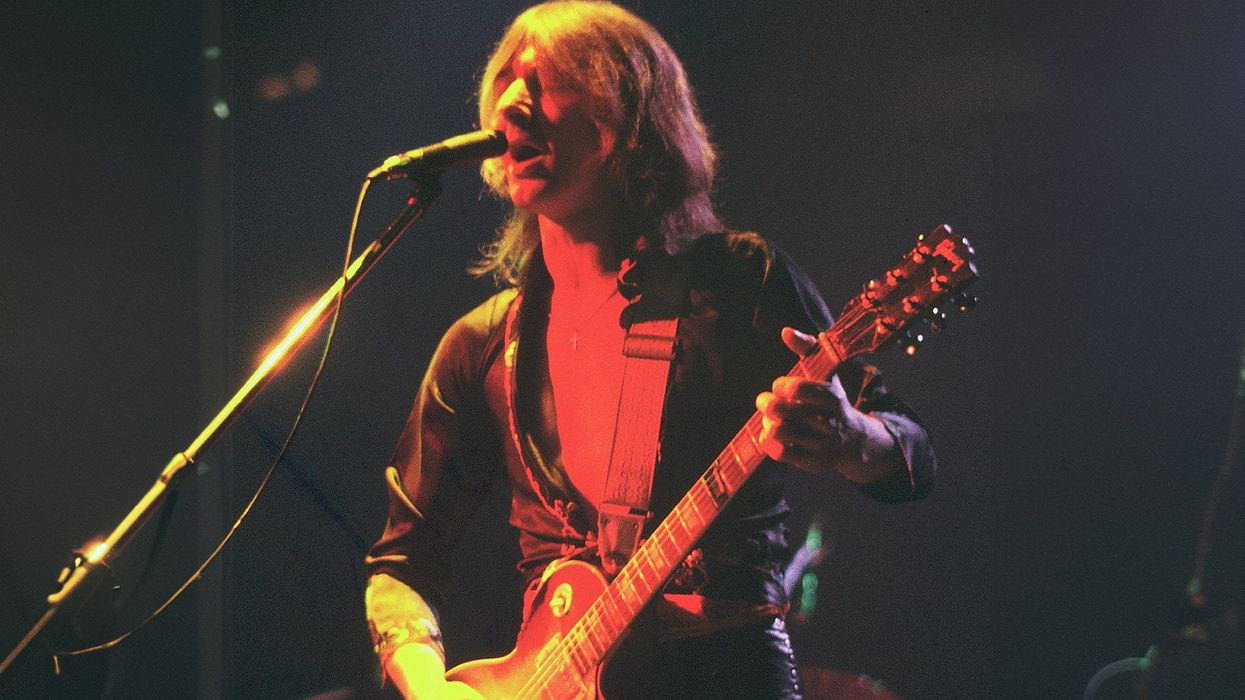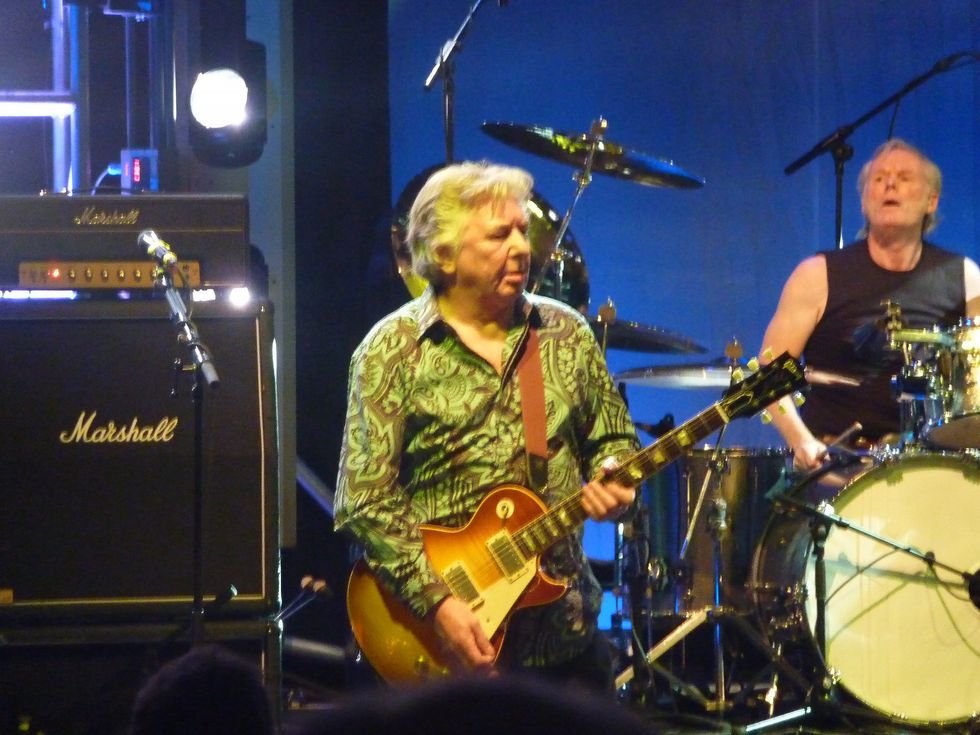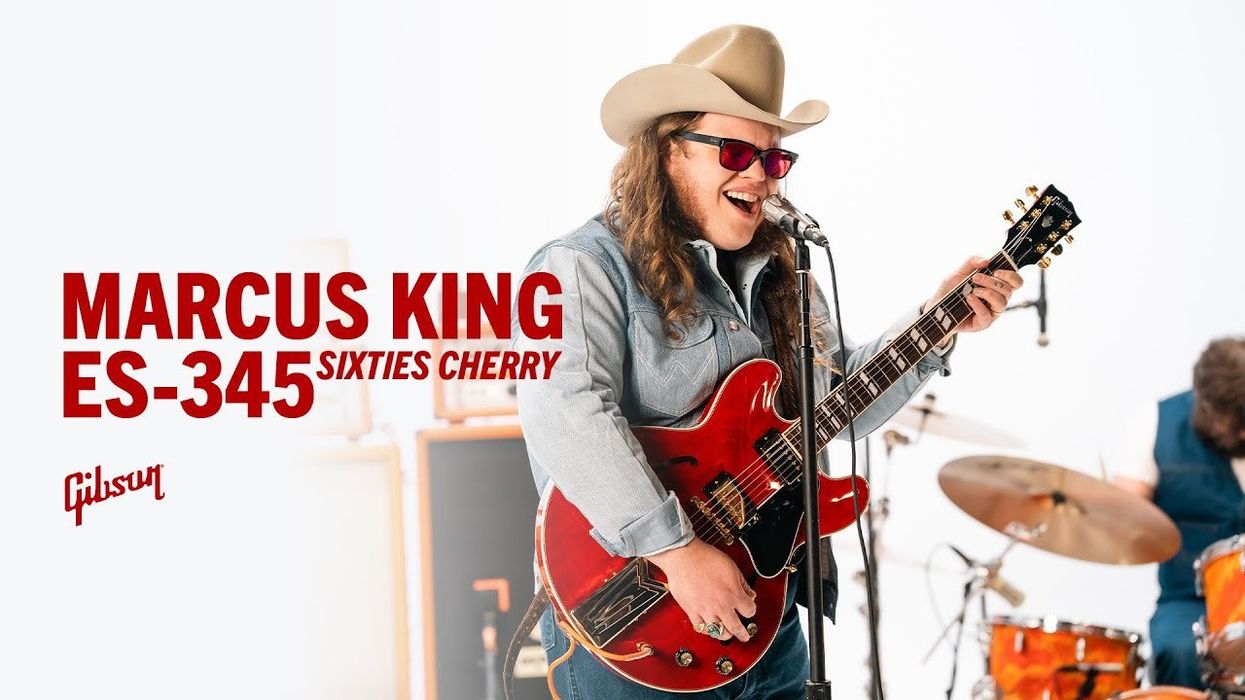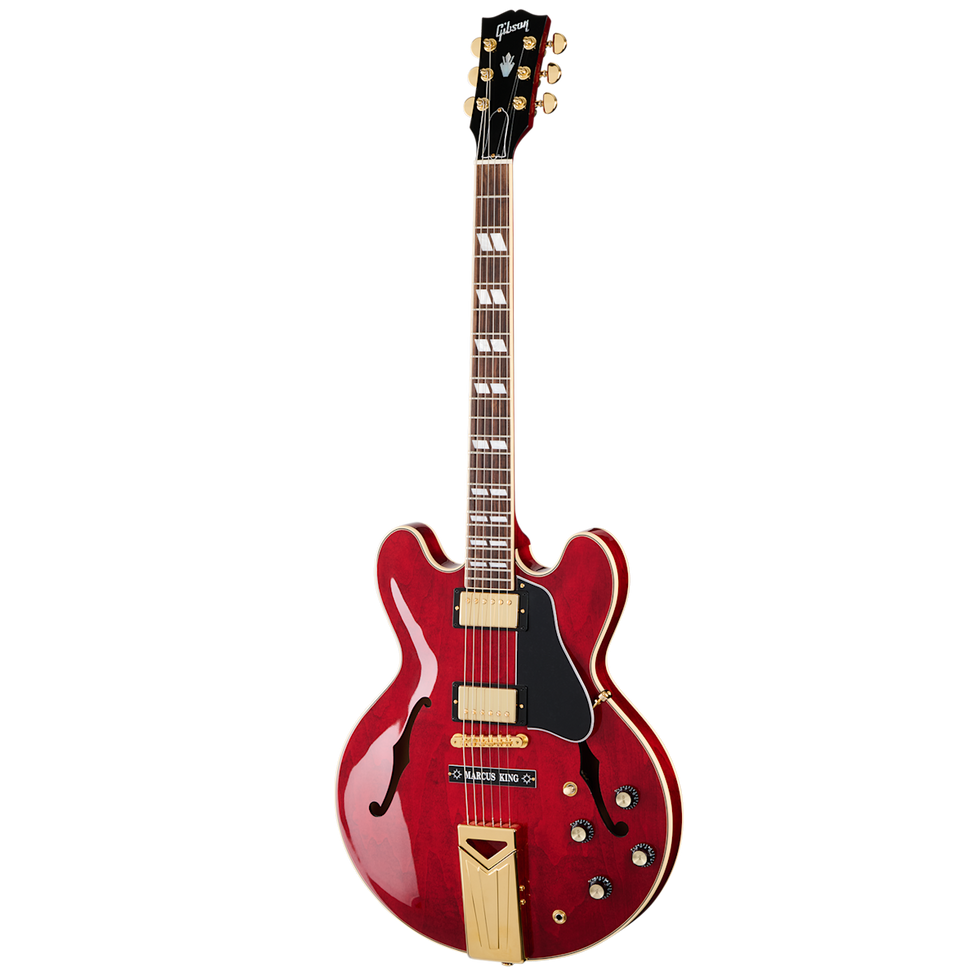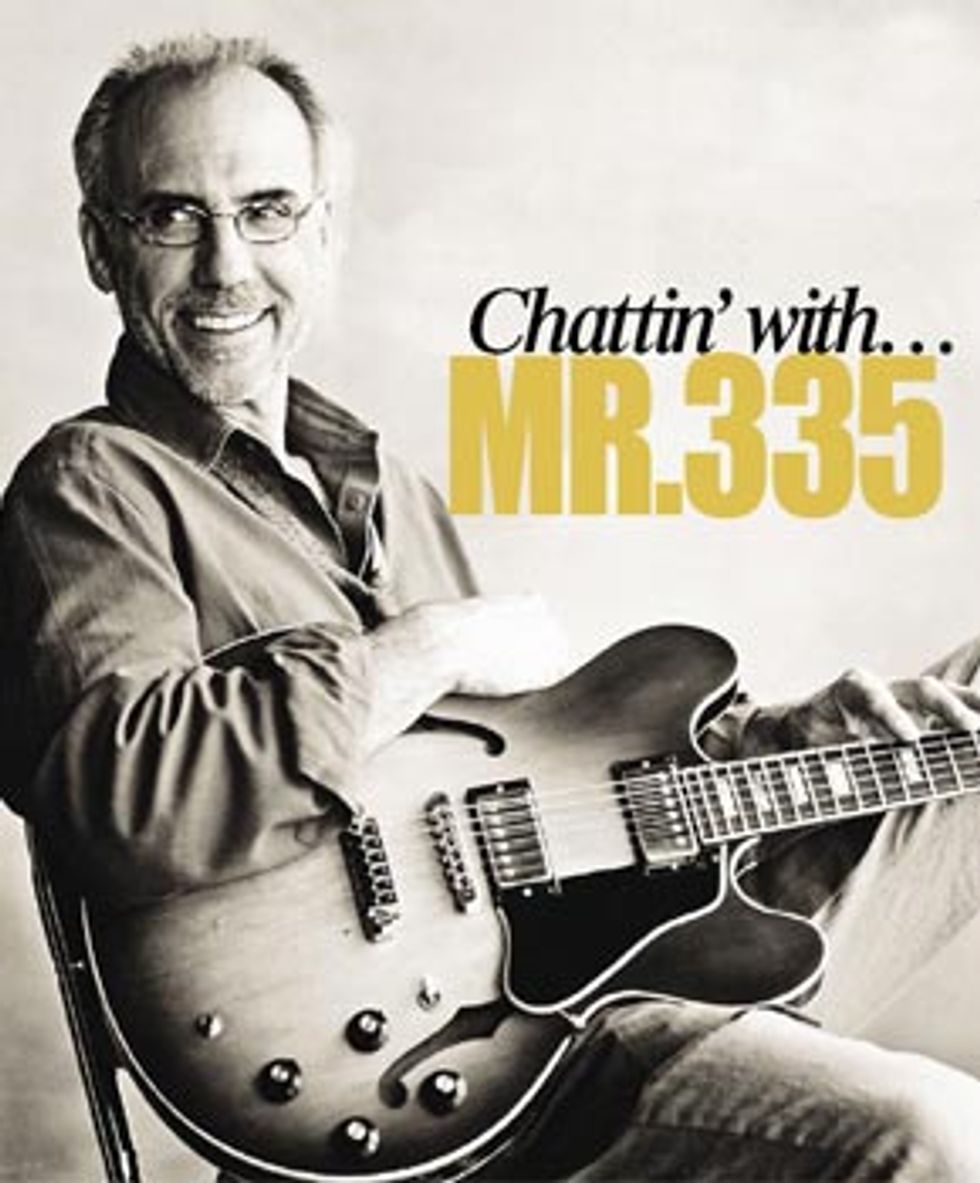 |
|
How did you get started playing the guitar?
You know I started playing the guitar when I was six years old. My mother played guitar when she was a teenager, so there was an old acoustic guitar lying around the house. My parents say that by age four I was fascinated with the guitar, but I was too small to hold it. My parents told me, “When you’re physically big enough to hold a guitar you can take guitar lessons,” so I started taking guitar lessons when I was six years old. I studied with the same teacher for about eight years, then my teacher actually told my parents, “I just can’t teach the kid anymore, we’re just going to be reiterating the same thing.”
Six years old is very young to start lessons – what was your teacher like?
His name was Slim Edwards, and he did a very cool thing that I appreciate in reflection. Because I was so young, my attention span for reading music and paying attention was more limited than an older kid. So for the first ten minutes of the 30 minute session, Mr. Edwards and I would just jam – a simple little boogie-woogie song, tap our feet and have fun. Then the next 20 minutes was focusing on some kind of scale, chord or reading exercise. I think it was very important for my development the way that Slim enticed me and kept me interested in pursuing the technical part of the guitar. I practiced at least a half an hour each day. If you picture an eight year old, that’s discipline, because there’s baseball and there are girls, and bubblegum and other things that boys do. The discipline was enforced by my parents, and they had to keep me on it sometimes. As much as I loved to play, I didn’t want to practice, and they would say, “Larry, come in and practice your guitar.” So I appreciate that discipline.
 |
|
How did you get started playing the guitar?
You know I started playing the guitar when I was six years old. My mother played guitar when she was a teenager, so there was an old acoustic guitar lying around the house. My parents say that by age four I was fascinated with the guitar, but I was too small to hold it. My parents told me, “When you’re physically big enough to hold a guitar you can take guitar lessons,” so I started taking guitar lessons when I was six years old. I studied with the same teacher for about eight years, then my teacher actually told my parents, “I just can’t teach the kid anymore, we’re just going to be reiterating the same thing.”
Six years old is very young to start lessons – what was your teacher like?
His name was Slim Edwards, and he did a very cool thing that I appreciate in reflection. Because I was so young, my attention span for reading music and paying attention was more limited than an older kid. So for the first ten minutes of the 30 minute session, Mr. Edwards and I would just jam – a simple little boogie-woogie song, tap our feet and have fun. Then the next 20 minutes was focusing on some kind of scale, chord or reading exercise. I think it was very important for my development the way that Slim enticed me and kept me interested in pursuing the technical part of the guitar. I practiced at least a half an hour each day. If you picture an eight year old, that’s discipline, because there’s baseball and there are girls, and bubblegum and other things that boys do. The discipline was enforced by my parents, and they had to keep me on it sometimes. As much as I loved to play, I didn’t want to practice, and they would say, “Larry, come in and practice your guitar.” So I appreciate that discipline.
“You know I started playing the guitar when I was six years old. My mother played guitar when she was a teenager so there was an old acoustic guitar lying around the house.”
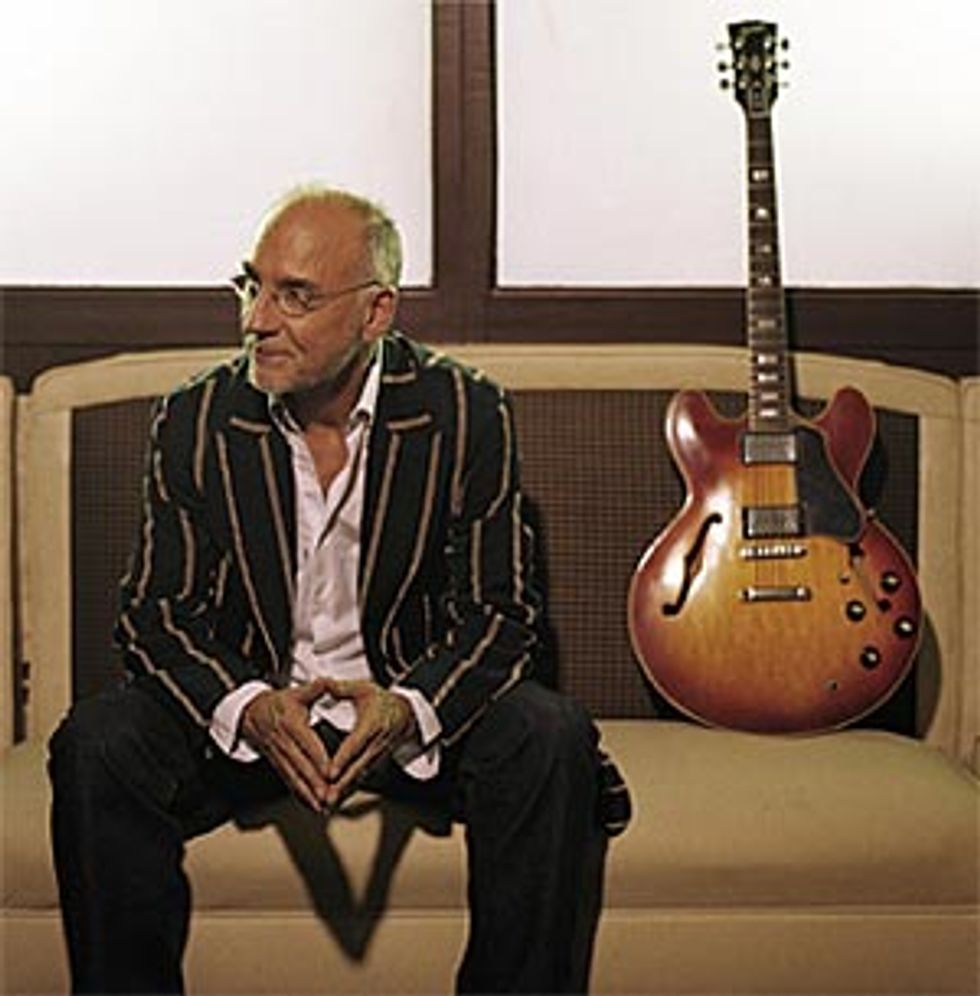
Around age 14, I came home one day and I heard the great jazz guitarist Joe Pass for the first time. Well that completely changed my life as a player. I wanted that. We went out and ordered the record that Joe was playing on. It arrived two weeks later, and my passion for jazz was born. I wanted to learn the solos, so I would sit with my guitar and the record, using my ear – I didn’t read the music at all. I developed my ear this way. Throughout my teens I played in surf bands, jazz trios and pop gigs, all while going to school.
You must have gotten a lot of attention as such a young player.
Well, it was obvious from age six to age 16 that I was this young kid with quite an aptitude for what he’s doing, so a lot of people were paying attention to my playing because I was so young. That attention continued through my teen years. When I would be playing at a club – a supper club, because I was too young to go into bars – people would notice. The more people started talking, and the better I started playing, the word spread beyond the Southern California and Los Angeles area to other communities – “Have you heard this young kid?”
All of a sudden I started getting calls for demo sessions and at 16-17 years old, I’d gone from playing in little clubs to being in the studio occasionally. One transition point for me happened when I was 18. I was getting called regularly to play guitar on demos for April Blackwood Music Publishing in Los Angeles. After a few weeks of these demos, I actually became the arranger because I had the ideas and I was into it. Once again, I’m networking and building a small reputation by just playing what I love. It snowballed and I got a call for a big session. At this point, I was still only 20 years old and word was spreading that I was playing well.
Is there any time that you would consider a major turning point?
I was in junior college in 1967 at Harbor Junior College in the San Pedro area of Southern California. I was in the music department, and they decided to put on a jazz concert. My little jazz trio headlined and by chance a record producer was there. His name was Harry Mitchell, and he wasn’t a big time producer, but he was in the music industry. He came up and introduced himself and asked if I wanted to make a record. Of course I said yes, and my first record was made in 1968. I was basically a Wes Montgomery clone – not nearly as good as Wes Montgomery – but I was in process of starting to express myself at another level. I made that record and it was played a lot on the jazz stations in Southern California during the summer after it was made.
In the meantime, I got a call from a gentleman who produced commercials for Ford. They had on-camera commercials for a group called “The Going Thing” – the jingle went, “Ford has a better idea, it’s the Going Thing!” They wanted to know if I would join their group, record these commercials, and then go do their corporate gigs during the summer. I had to make a decision now; do I make my second album or do I join this group? I chose to join that group, and I started to meet studio musicians. Like before, the studio musicians heard me play, word spread and I started getting calls for session work.
Had I not taken “The Going Thing” Ford gig, I probably would have ended up being a jazz soloist from age 20. I’m very happy about the decisions I made, because in the studio, playing with the greatest musicians every day, it elevated my musicianship to a much higher level and at a much faster pace than it ever would have been developed otherwise.
How long did you do session work?
I was a studio musician for seven solid years – 1970 to 1977 – starting at age 23. I averaged 15-16 three-hour sessions each week for seven years. During this time I did just over 3000 recording sessions and was fortunate enough to have worked with many of the better-known stars of the time – Barbara Streisand, Michael Jackson, Joni Mitchell, Steely Dan, David Cassidy and the Partridge Family. I did 13 albums with the Crusaders. I was a very blessed man to have all of that happen, and I learned from the musicians I was playing with. Imagine, I was 23 years old and playing with Joe Sample of the Crusaders. That kind of input influenced the rest of my life musically. It’s been a wonderful ride; that session part of my life was very special to me.
Are there any pieces of advice that stick out in your mind from working with so many great musicians?
When Louis Shelton – the most tasty guitar player of his time, in my opinion – would play on a record, after it was mixed and I would hear it on the radio, his guitar was right up front by the vocalist with the perfect part. I had played on many sessions and my guitar was always kind of mixed back in the track and not so prominent. One day I was walking down Sunset Boulevard between sessions with Louis Shelton and I asked him, “Lou, how come they mix you so hot and they don’t mix me as hot as they do you on a record?” He responded, “Larry, I try to think like an arranger.” That was a light bulb moment for me – I’d been thinking like a guitar player.
When did you hook up with the 335?
The romance between Larry Carlton and the ES-335 started in 1969. I was getting calls to do sessions, and I had to jump from studio to studio, but I never knew what style of music I was going to be called upon to play. I love jazz, I can play rock and roll and I can play country music, so I was looking for a guitar that could cover all those bags. I needed a guitar that was – and is – as versatile in sound as I was as a player. After checking out a few things, I decided that the Gibson ES-335 was right for me. I could play my jazz things – I love jazz and I love the f-hole and the semi-hollowbody sound – but when you put on the treble pickup, you can get it to scream on the amplifier. Versatility, versatility, versatility – that’s why I chose this guitar.
“I was a studio musician for seven solid years – 1970 to 1977 – starting at age 23. I averaged 15-16 three-hour sessions each week for seven years. During this time I did just over 3000 recording sessions and was fortunate enough to have worked with many of the better-known stars of the time – Barbara Streisand, Michael Jackson, Joni Mitchell, Steely Dan, David Cassidy and the Partridge Family.”
Why do you think your session career blew up so much?
I think there are a number of reasons that my studio career continued as it did. I would work for a producer once, and the next time he worked, he would call me back to play on the next session. I know that one of the reasons those call backs came was because of my versatility.
The era in which I was born and started playing the guitar was unique to me. As a six-year-old kid in the late ‘50s, I heard doo-wop music on the radio while I was studying the guitar. In the early ‘60s, rock n’ roll was starting to happen with pop music – the Beatles in ’64, for example. I was exposed to all these different styles while maintaining my passion for jazz. As I matured into my 20s, I had an arsenal of different styles that I was very familiar with and could bring to the studio scene. That was definitely one of the major contributions that I could make to a session. Versatility was my calling card.
Prior to the ‘70s, there seemed to be two kinds of studio guitar players. On one hand, there were the gentlemen who could read any sheet music at all, but they didn’t listen to rock n’ roll. On the other hand, you had guys who were listing to Jimi Hendrix and Eric Clapton and all those guys, and they could play like fire but they couldn’t read any music, so they had no versatility. When I stepped on the scene, I seemed to have been the first guy who understood both of those worlds because of the time I was brought up in.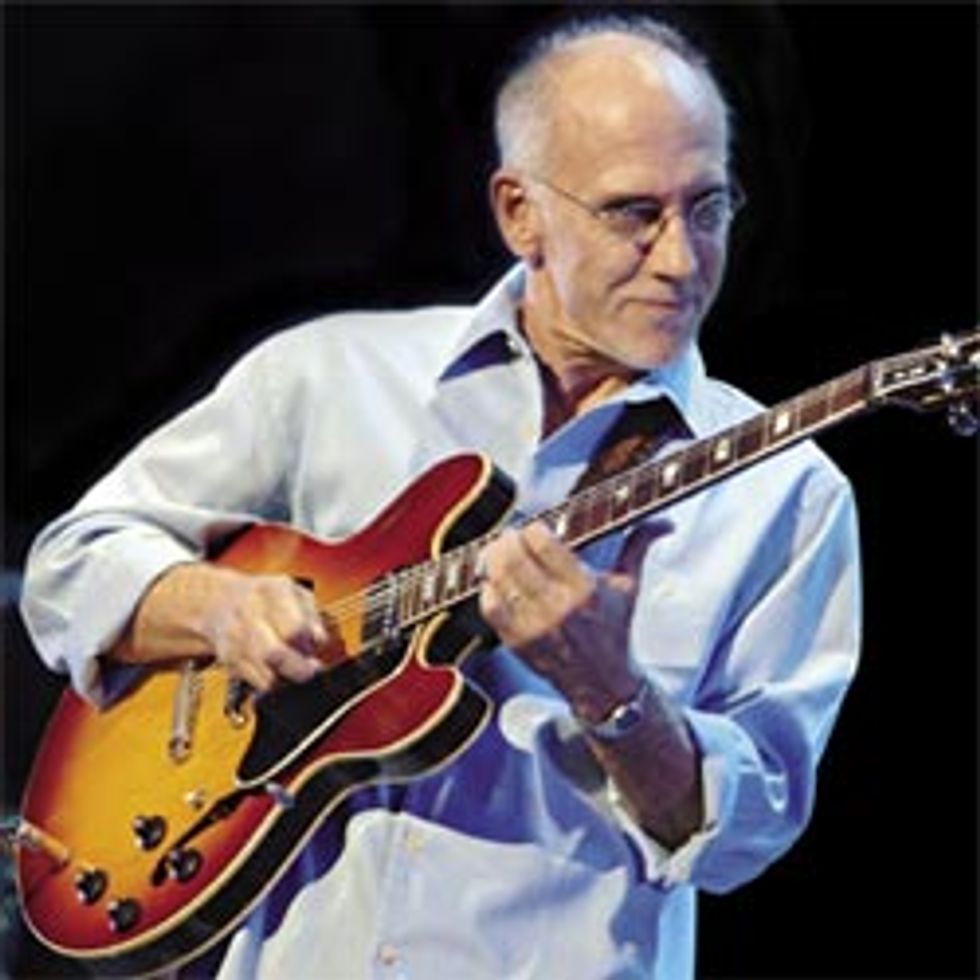
During the last couple of years of my session work, I was also being called as an arranger for records. I arranged things for Barbara Streisand, Joan Baez, and a number of people. I enjoyed doing that because I had been playing the guitar so much that it felt good to just not play the guitar, but to write the parts out and lead the session. I was in transition from being studio player to studio arranger.
In 1977 I felt like it was time for another transition, and that was to producer record. I discontinued all session work as a guitarist and only put the word out that I was now producing. At the same time, I started playing at a local jazz club for fun because I wasn’t burnt out doing sessions all day. When playing at the local jazz club, a representative from CBS records came up after listening to me play and said, “Ever think of making a solo album?” It just happened; I was in the right place at the right time, the gentleman heard me and my solo career started from there.
CBS said, “We want to sign you, but we want X producer to produce you.” And I was strong enough, just cocky enough to know that until I failed at producing myself, I didn’t want somebody else telling me how to play. I was willing to pass on the gig. So I said, “No, no, let me produce myself, and if I fail, I’ll go with one of your guys.” And they said no. So I took one of my demos and sent it to Warner Bros., who said, “Go do your thing.” I produced myself in my own studio and I’ve produced myself ever since.
Tell us about your solo career a bit.
In 1979 I made Larry Carlton, the first Warner Bros. album and it became quite successful worldwide. I went to Japan and played major venues. It was interesting – in ’79 the Larry Carlton album came out and in 1980 I won my first Grammy with Mike Post for the television theme “Hill Street Blues.”
By 1984, I’m still on Warner Bros. and I decide to do an album called Friends, so I call a number of my friends to come in and perform with me – David Sanborn, Michael Brecker, Joe Sample, B.B. King,
Al Jarreau, Jeff Porcaro, and Abe Laboriel. I was on such a musical high from all of the opportunities and choices that I could make. The Friends album was a great success as well, but the industry changed. I got a call from the head of Warner Bros. and he said, “Larry this is not about you, but we’re not going to have a jazz department starting in 1985, so we’re going to let you go – you’re free.”
For two years I decided that I didn’t want to have a record deal. I wanted to loaf and play guitar. Then, I got a call from an old producer friend, Jimmy Bowen, and he and Tony Brown were starting a label in 1986 called the MCA Master Series, and they asked me to record a little boutique album for them, something I had never done before. I had never done an acoustic guitar album before, so I went in and made the Alone or Never Alone album. “Smiles and Smiles to Go” was on that album and became a career song for me. I had to follow that up, so the next year, 1987, I did the Discovery album and won a Grammy for the performance of “Minute by Minute.” Michael McDonald played on that with me, along with Kirk Whalum. The solo career thing has been working, working, working.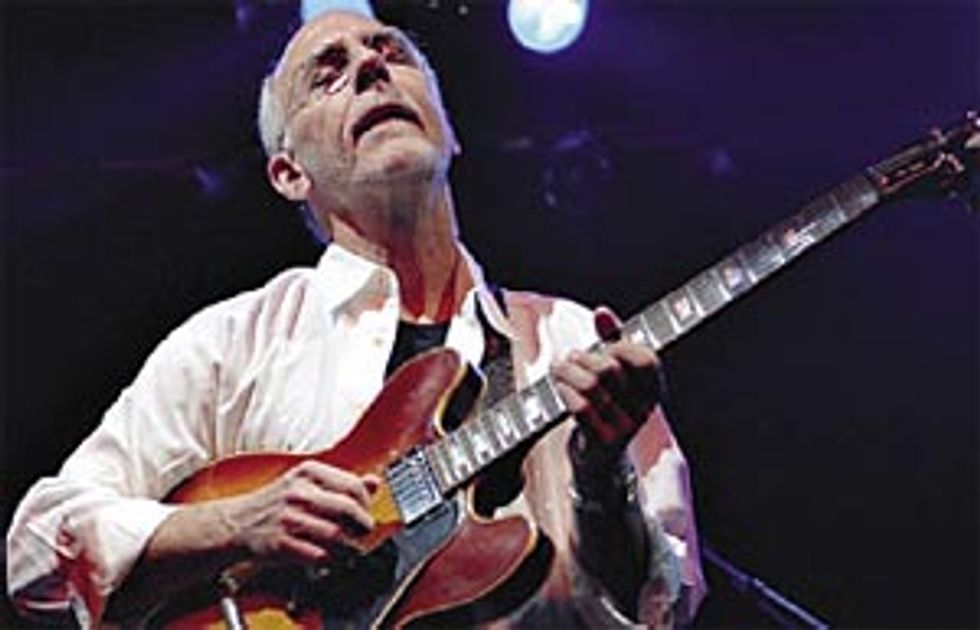
In April of 1988, I was at my recording studio in the Hollywood Hills. I was in the office part, and the door to the office, which was facing the street, was open a little bit. I noticed looking out into the street that there were two young boys jogging, and there was a German Shepherd dog jogging with them, so I went to the door to shut it so that the dog would not come in the office. As I got to the door to shut it, I was just ready to shut it and one of the boys, who was just maybe 20 feet from me, pulled a gun from behind his back and fired one shot and hit me in the throat.
The bullet severed my carotid artery, blew away the nerve to my left vocal cord – so I only have one vocal chord – and it lodged in my back and traumatized all of the nerves to my left arm. Luckily, through major surgery and months and months of rehabilitation, the nerves in my left arm down to my fingers have rejuvenated. During that whole 6-8 month process, I had lost the use of my left arm. I could not squeeze toothpaste; I carried my left arm with my right arm and it had completely atrophied. The physical therapy stimulated the nerves in my left arm to rejuvenate and finally feeling started coming back.
After about seven months of not being able to play the guitar, some of the feeling started coming back. I had a little acoustic guitar sitting at the house and one evening I picked up the guitar and could actually finger a baby chord again. God had blessed my left arm with some nerves and it was now time to build muscles. I did all the physical therapy and built the muscles in my hand so that I could play again. I believe it was December of 1988 that a number of my friends got together and we enjoyed a comeback concert to celebrate the return of my abilities.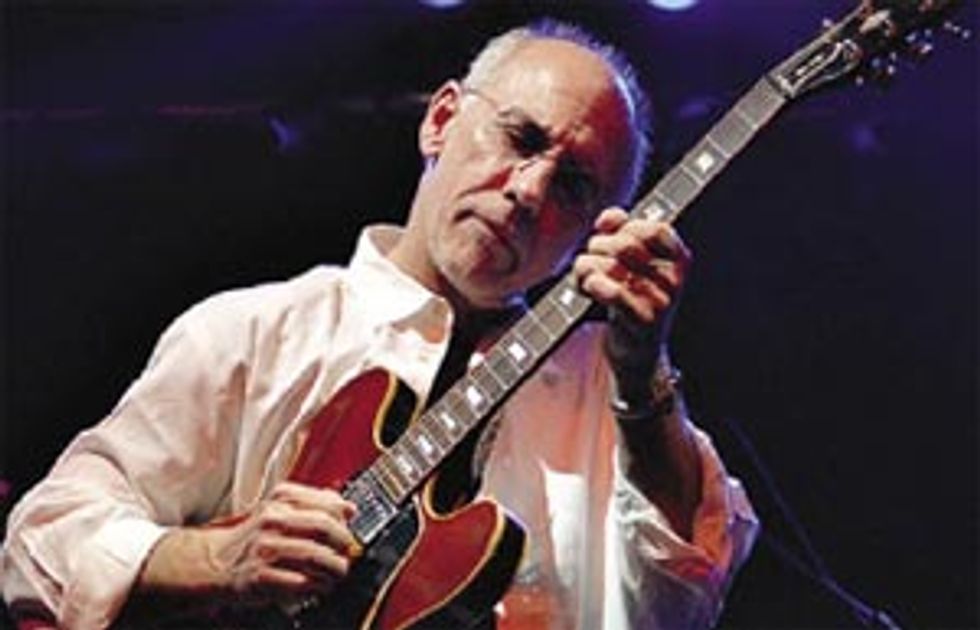
Going through and then coming out of that tragic event when I was shot did leave me a different man – I was a different person once I had healed. I didn’t know it at the time, it wasn’t a revelation, like, “Oh I’m a new guy! I just made it through a shooting.” It really came out through conversation.
One conversation that I remember specifically was with my son Travis, who was just turning five at the time. Once I was well enough, well into the process of healing, he and I had a conversation. He said, “Dad, why did they have to shoot you?” And the truth, I think, comes at those moments when you are relating to your children, and what came through my spirit and out through my mouth was, “Trav, why not me? I’m just another daddy in this world.” And what I realized after I spoke those words and time went by, is that although I’m very talented at playing the guitar, let’s set the guitar down and really understand who we are as people in this world. I truly believe I am just a guy in this world going through the process with everyone else, who just happens to play the guitar. After the shooting and after going through the recovery, people observed a difference in the way I played the guitar. They heard things that I didn’t even know I was doing – not technical things, but passionate, emotional things. After I would play a solo or after the show, a number of people would come up and say, “I’ve never heard you play the guitar like that.” Those emotional events somehow brought out a deeper side of Larry Carlton the musician. And once I was aware, I felt the difference as a player. So yes, I was a different man and a different guitar player after being shot and recovering, and it showed up in my performance.
How did Fourplay come about?
In the early ‘90s, as I continued my solo career, I did an album called Kid Gloves and another called Renegade Gentleman. Both were moderately successful, but in 1996, I got a call from Bob James, the great pianist arranger, and he asked me if I would like to join the group Fourplay with Nathan East and Harvey Mason. It took me about three seconds to say, “Sure Bob! When do we start?” Once again there was another breath of fresh air in my career. I got to go play with three world class musicians who took every other year off from the group to continue our respective solo careers. We’ve had enormous success and Grammy nominations with Fourplay while still being able to continue our own solo careers.
Obviously you’re known for the Gibson ES-335. How else do you achieve your signature tone?
So my tone is a conglomeration of a lot of things, obviously. My touch, the way I choose my dynamics during a phrase, the amp I choose to play through, the way I set up my guitar, and also the attitude that I have the day of the session or the solo that I’m playing. You hear all of those elements come together for a tone at the time that I am playing the guitar.
“Now I’m getting to fulfill all of my musical dreams. My first project was to record a blues album with a horn section, which I called Sapphire Blue. We recorded the whole album in two days. It was so passionate and fun that we got it all done because of the spirit of it.”
Your solo on Steely Dan’s “Kid Charlemagne” is pretty legendary. Are there any secrets to that tone?
I played the same 335 on 90% of my solo sessions, including the solo for “Kid Charlemagne.” I just used a little Tweed Deluxe amplifier. There’s video of that rig on my website. The combination that I used sound-wise for the “Kid Charlemagne” solo was the 335, Tweed Deluxe amplifier, back pickup and with the tone control turned down to about three.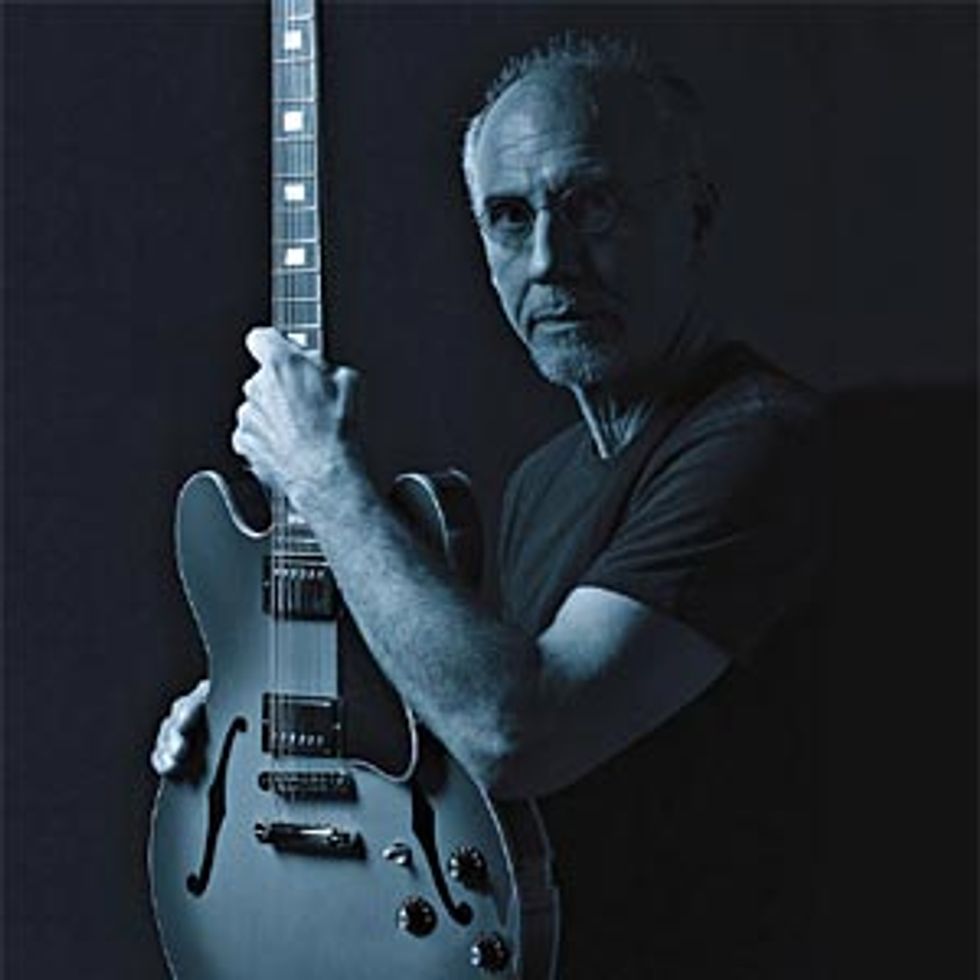
For years I did like everybody else – we had the effects coming out of the preamp – and it dawned on me that we should just simplify it. In the studio, the guitar comes up through the microphone into the console, out of the speakers and then on through a send, where they would add the reverb and the effects, so the sound hitting the effects is from the speaker through the microphone, not from a preamp through the back, and not direct from my guitar. So now live, I have the microphone on my guitar, send the sound of the microphone into a module, bring it up as a send, and have that hit the reverb. And for my ears, it made all of the effects sound better because I was used to hearing it in the studio.
My dry guitar is in the center and the only thing surrounding me, like in the studio, is just the effects. And right now I’m just using a little reverb. There’s a chorus set up in case I do a ballad, but other than that it’s really simple – no stompboxes or anything for me; I’ve gone back to guitar and amp.
You recently left a major record label to do your own thing, right? How has that been?
For the first time in 17 years, I left a major record company by choice so that I could do anything I wanted to do creatively. Now I’m getting to fulfill all of my musical dreams. My first project was to record a blues album with a horn section, which I called Sapphire Blue. We recorded the whole album in two days. It was so passionate and fun that we got it all done because of the spirit of it.
There’s a new breath of energy in my career, this time because I¹m free. I just released a new CD and live performance DVD with my good friend Robben Ford and now have several other exciting recording projects underway. We also just overhauled my website (larrycarlton.com) and launched Mr. 335 TV (mr335.tv) so that I can do a better job sharing information, lessons, performances and a few tricks of the trade with my audience wherever they happen to be in the world.
Any particular insight that you''d care to share with Premier Guitar readers?
Practice what you must. Play what you love.
| The Next Step: 335 Records |
 After finding freedom from major record labels in 2003, Larry Carlton has embarked on his own exciting journey in recording – 335 Records. For Larry, the appeal of starting his own record company was simple: “I get to choose any piece of music and any artist I want to present to my audience.” After finding freedom from major record labels in 2003, Larry Carlton has embarked on his own exciting journey in recording – 335 Records. For Larry, the appeal of starting his own record company was simple: “I get to choose any piece of music and any artist I want to present to my audience.”Talking with Larry reveals a bit deeper motive however – one in keeping with his undying devotion to his fans. “With 335 Records, I can focus totally on interacting musically with my audience. We’re pretty tuned in to each other and now I have the means to produce the music and artists that I know they’ll appreciate.” With decades of recording experience, a multitude of talented friends in the industry, and technology on his side with Mr. 335 TV, Larry seems to have found the perfect combination. Larry says his goal is to watch what his audience responds to and pay strict attention to what they want to hear. The first release from Larry’s 335 Records does exactly that. Fans of Larry and Robben Ford had been asking for years when they were going to get together. Since their meeting in 1974 when they were both working with Joni Mitchell, anticipation had been building for collaboration. “I’ve been a fan of his all of these years,” Larry recalls, and now more than 30 years later, the two friends came together for a live CD and DVD recorded in Tokyo, Japan. Both guitarists wrote new songs for the album, which was recorded live at the famous Blue Note Tokyo club. Larry Carlton with Special Guest Robben Ford, Live in Tokyo was released in early 2007 and features eight tasty tracks that will downright delight the many fans of both artists. |
| Mr. 335 TV - Larry’s Silver Screen |
|
Interested in learning more about Larry’s career and background? How about picking up some priceless insight gleaned across 3000 recording sessions? Or maybe you’d like to beef up your chops with dozens of video lessons from the master himself? It’s all just a few clicks away on Mr. 335 TV. In a rather unprecedented move, Larry Carlton launched a self-hosted Internet TV station, Mr. 335 TV, to the delight of fans around the world. More than 100 different videos bring Larry’s world to your desktop, including reflections on his past, technical tips for vibrato, bending and more, and detailed descriptions of his current and past rigs – check out the Steely Dan rig! – and that’s just scratching the surface. Mr. 335 TV plans to add to the already expansive list of videos with regular updates as a way for Larry to communicate personally with his fans. In this way, it is unlike anything any artist has ever done before. Carlton is the first major artist to provide such a wealth of video content for their audience. We can only hope that more of our favorite artists take a look at this station and immediately follow suit. Thanks Mr 335! |
Larry’s Gearbox
|
Larry Carlton
larrycarlton.com
mr335.tv
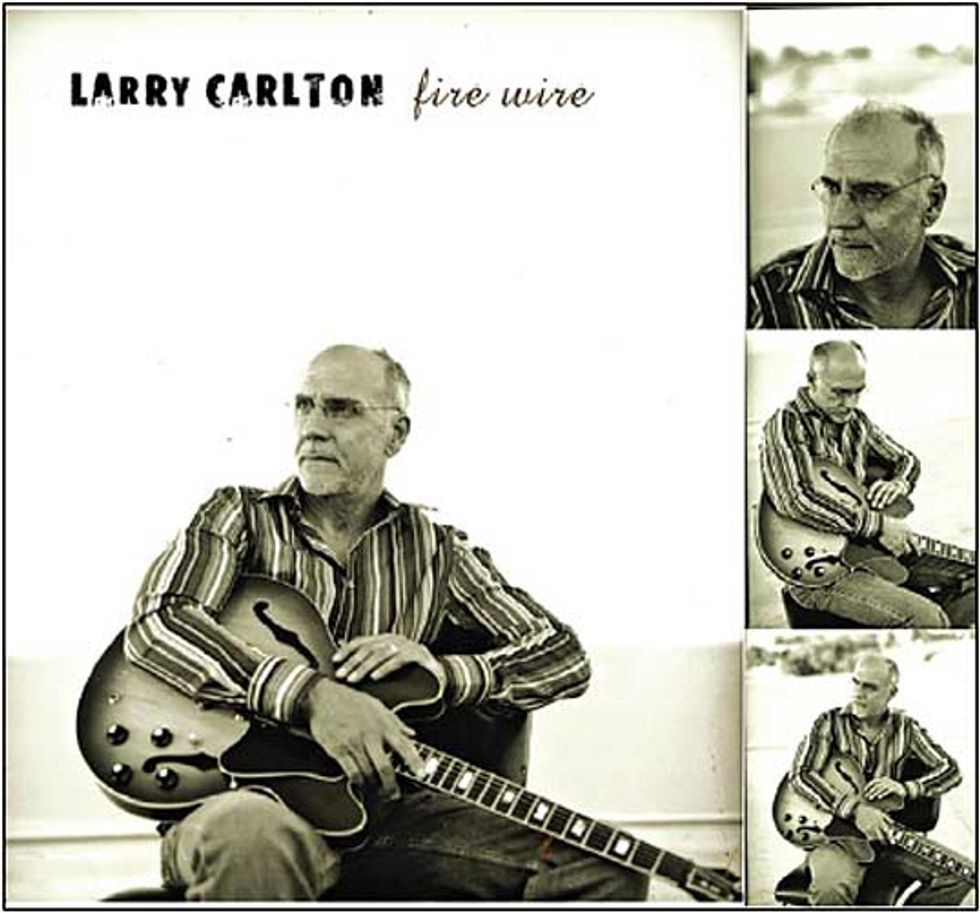
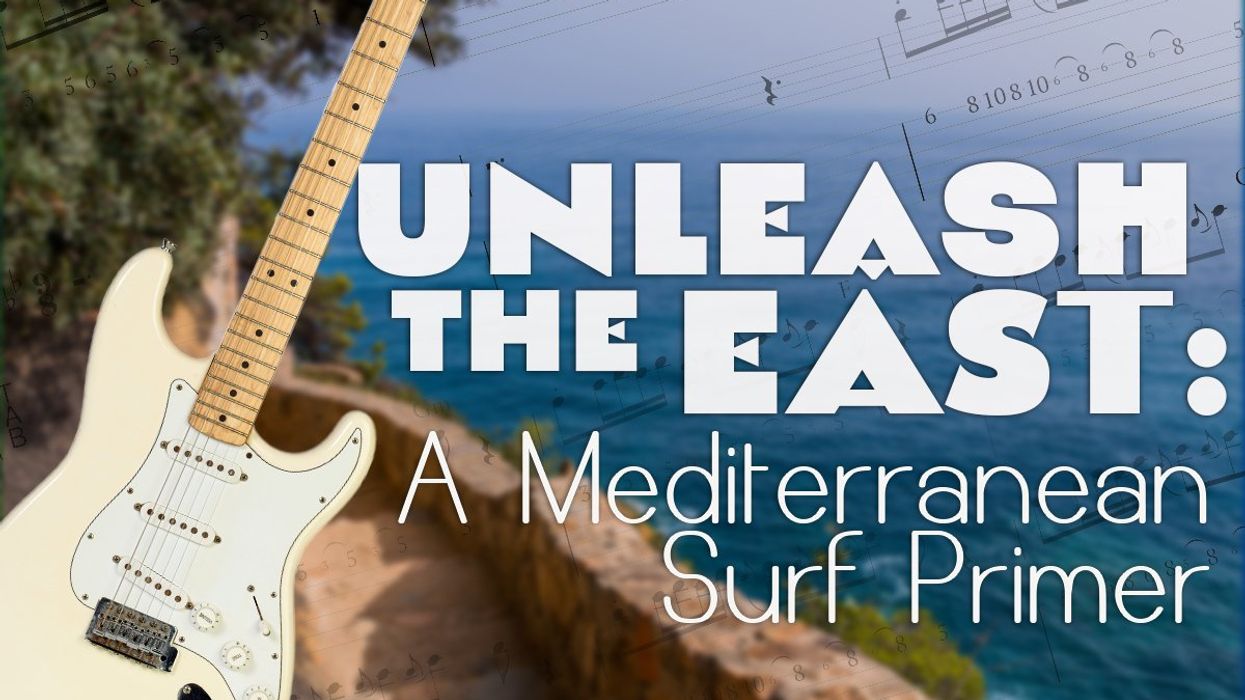
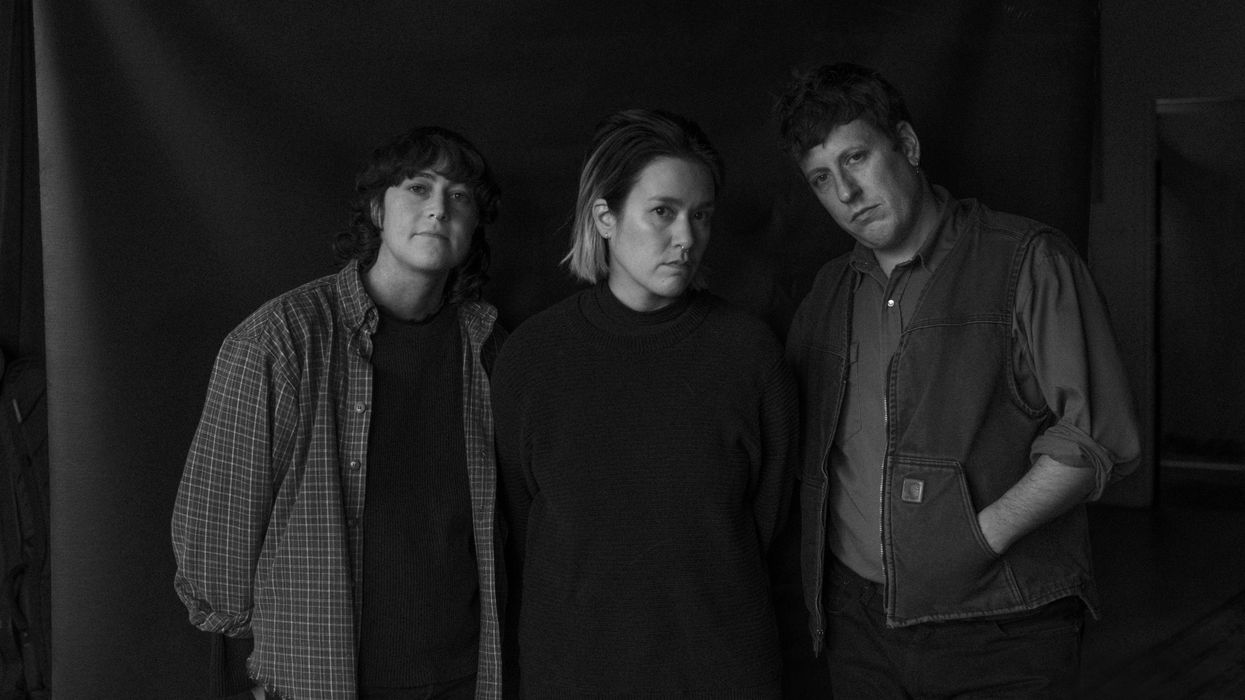
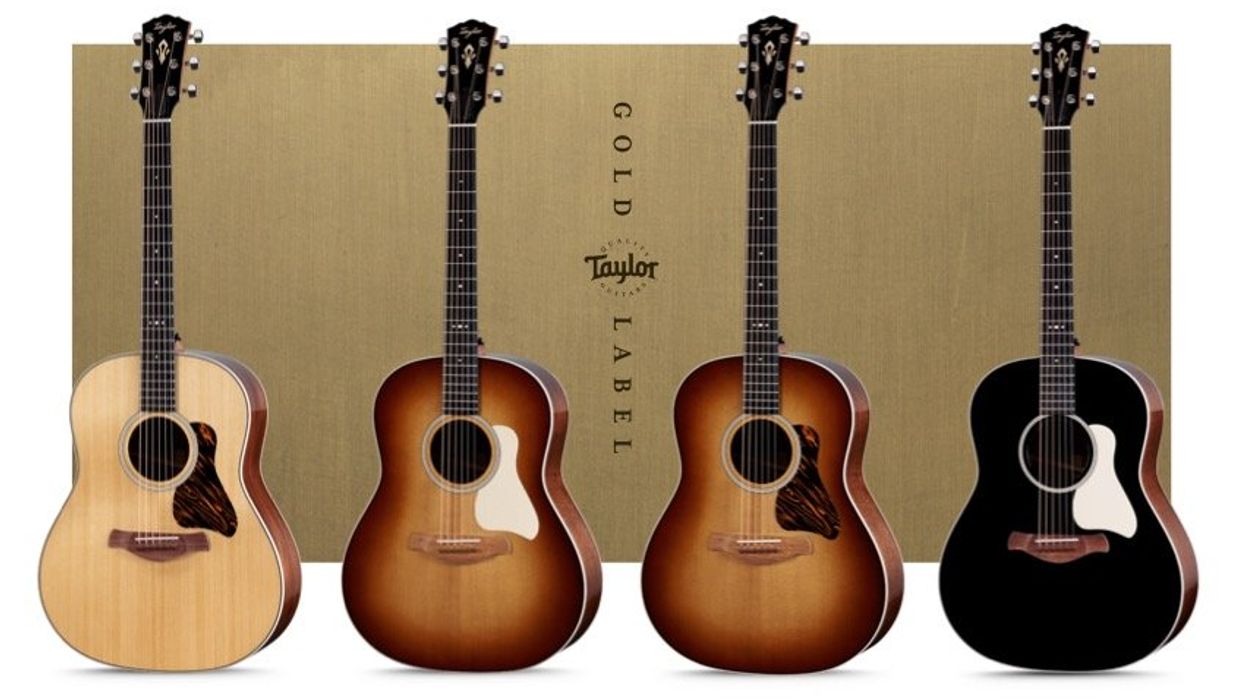
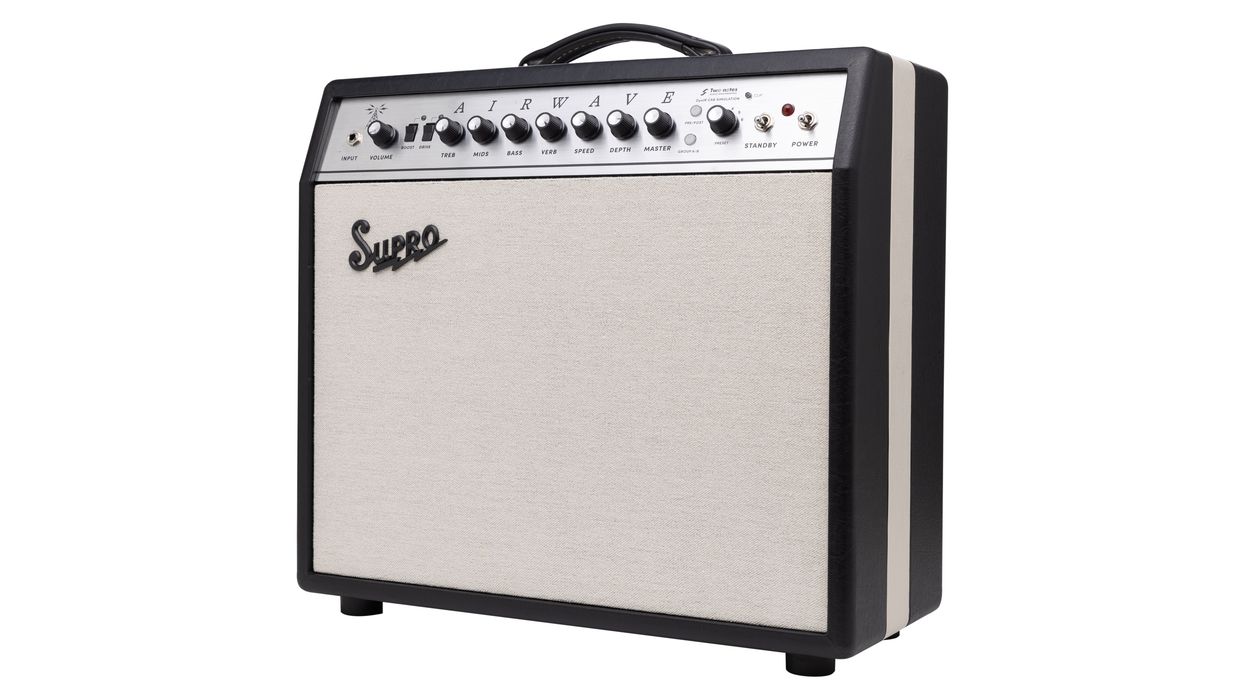
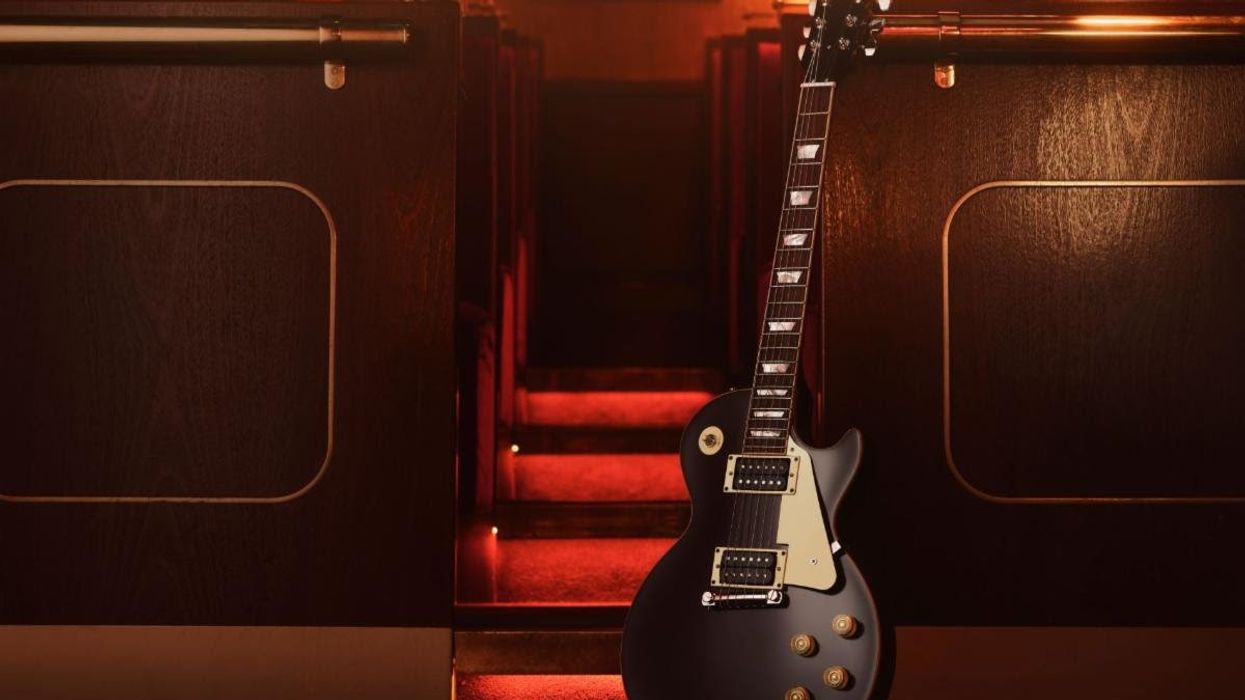

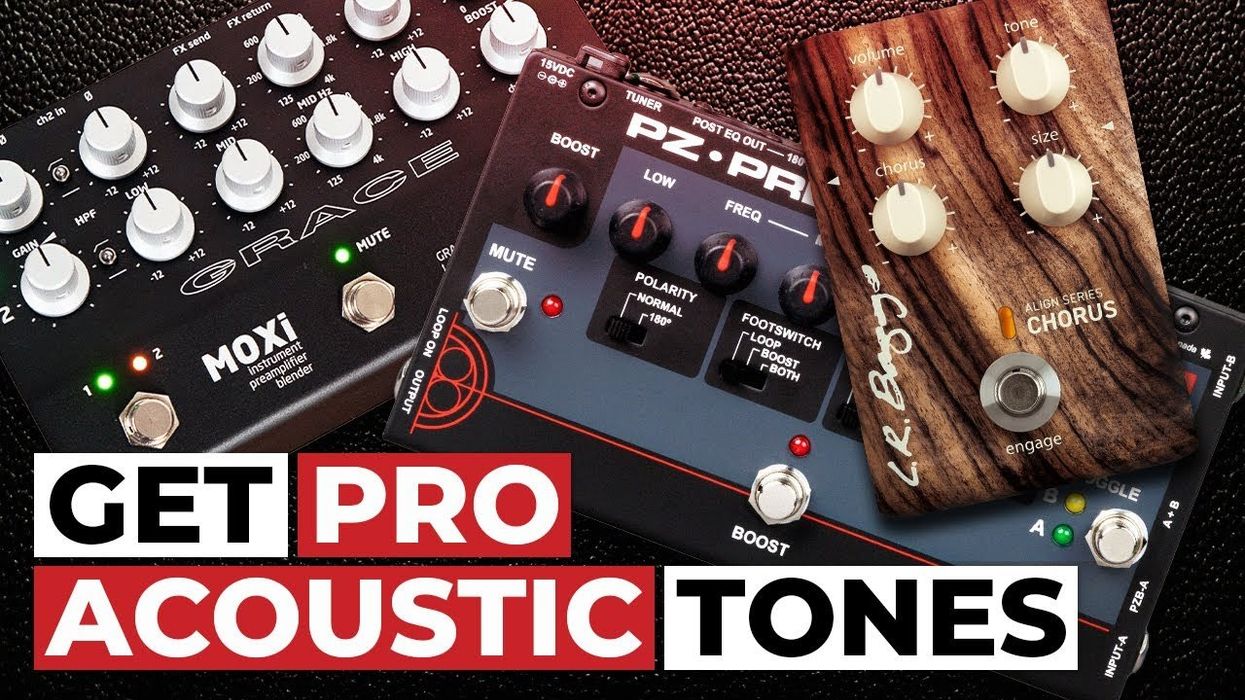
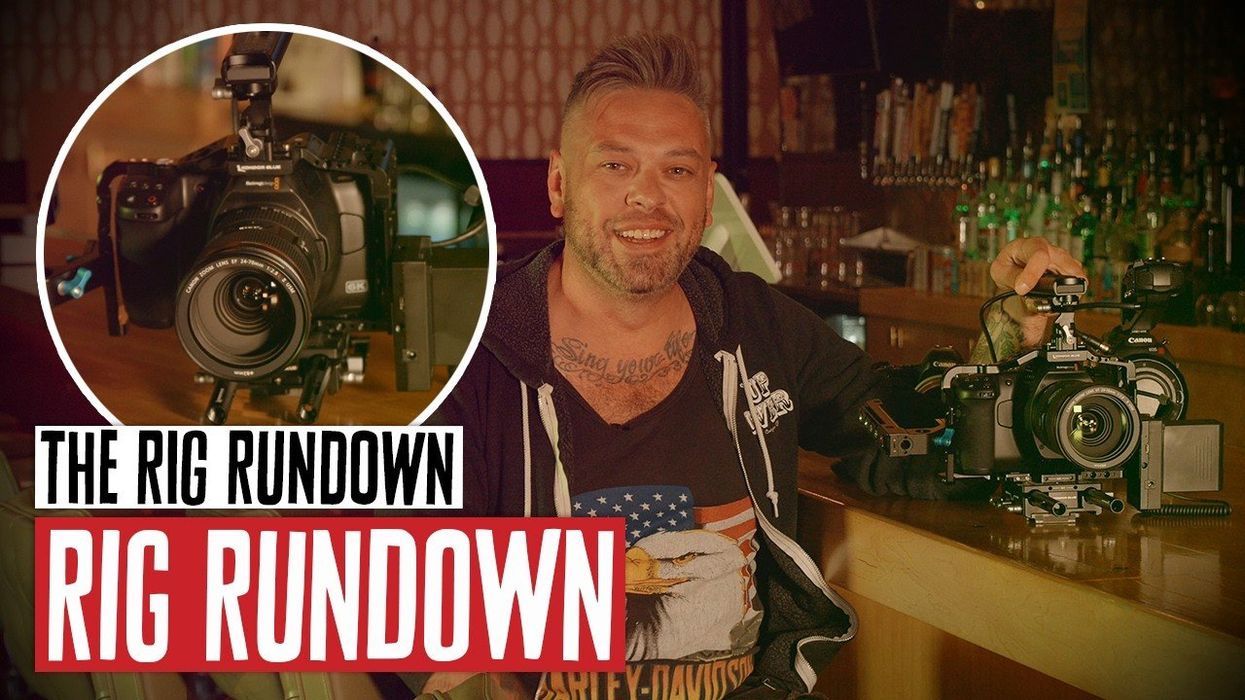
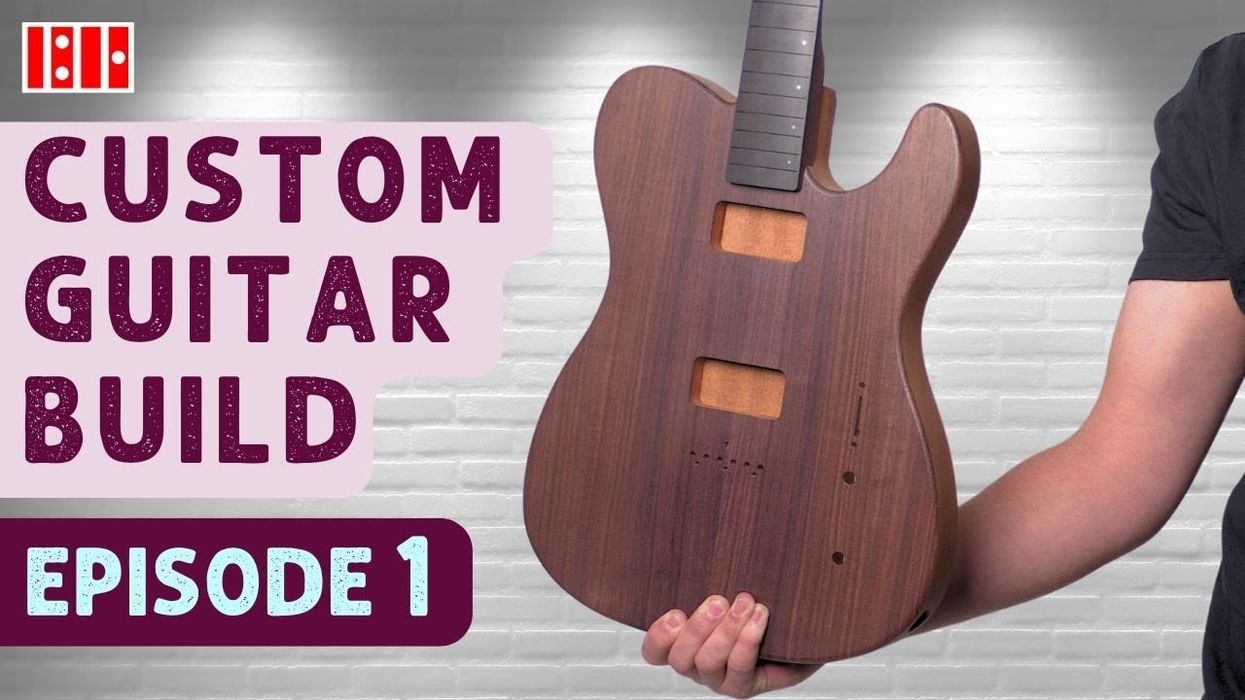
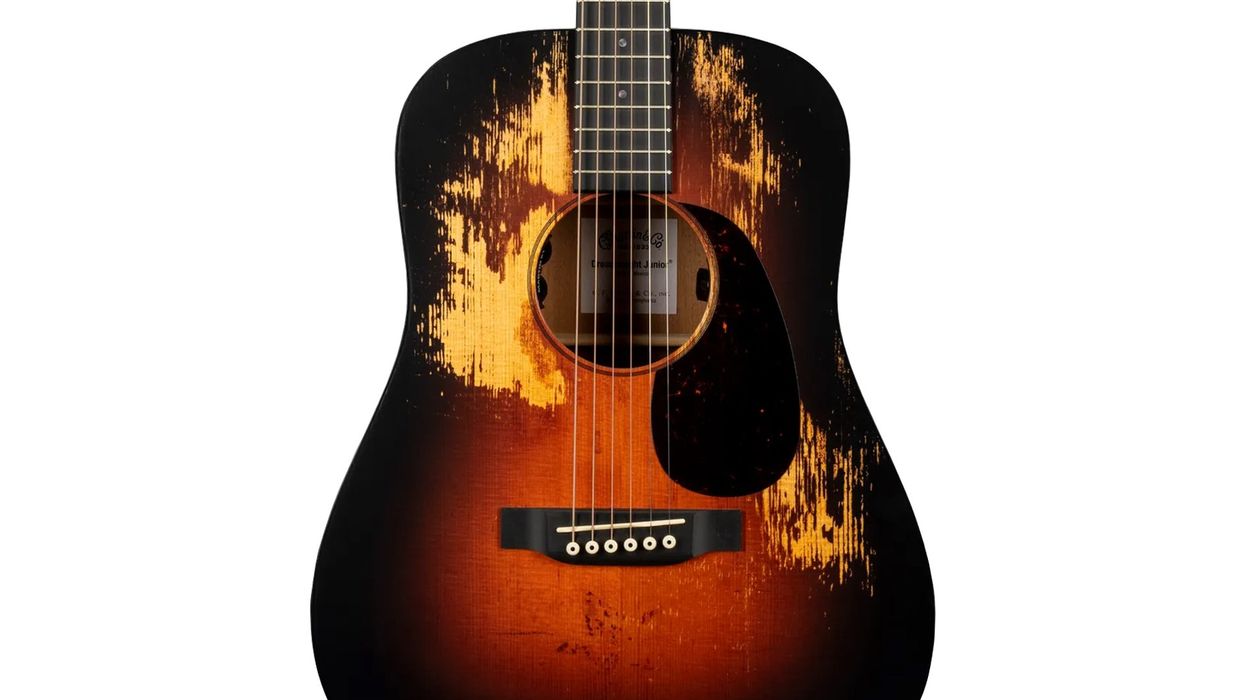
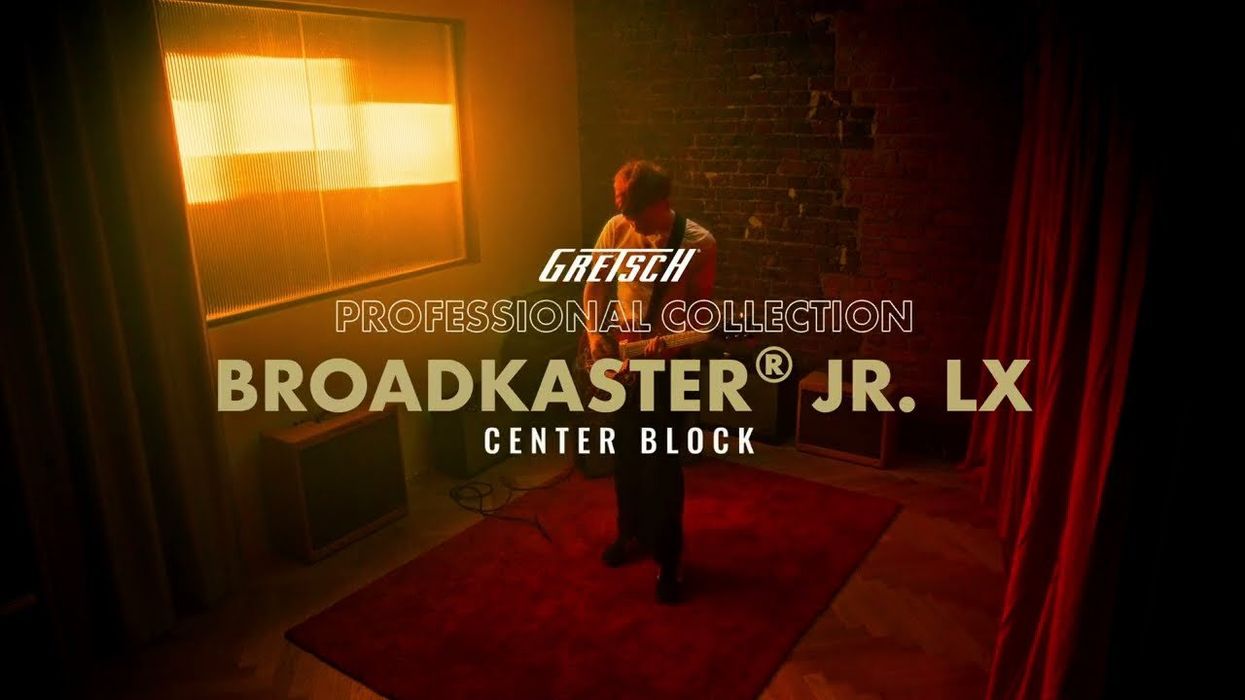
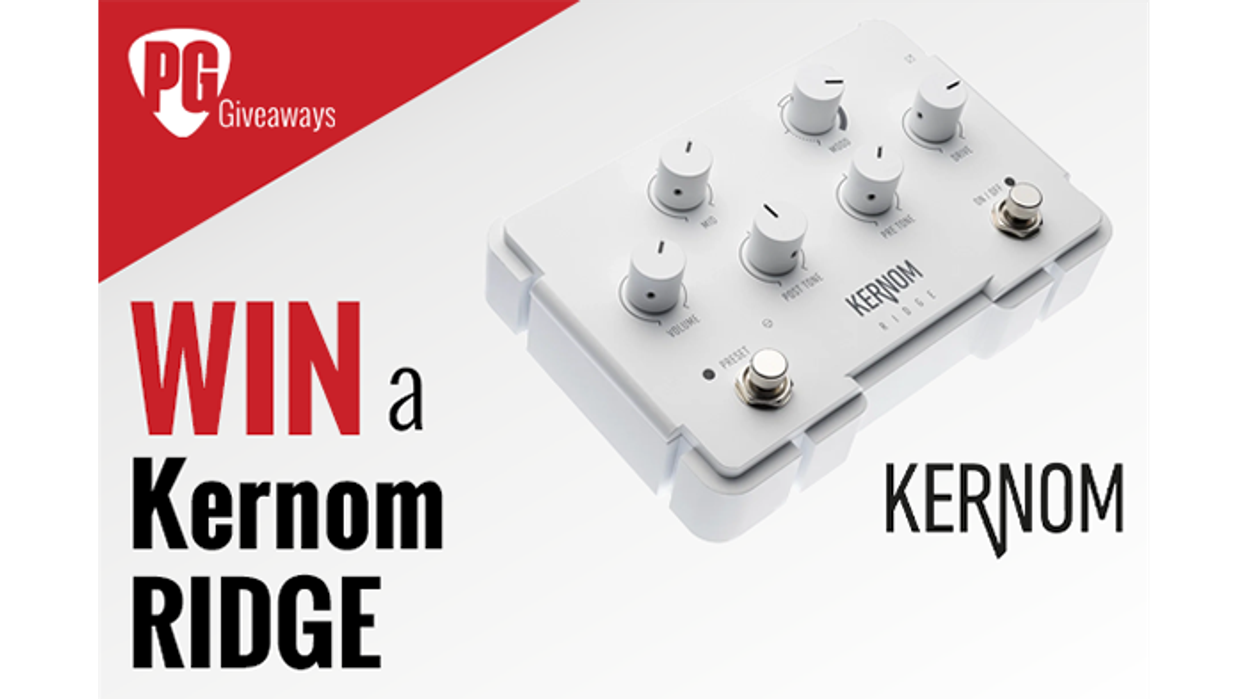
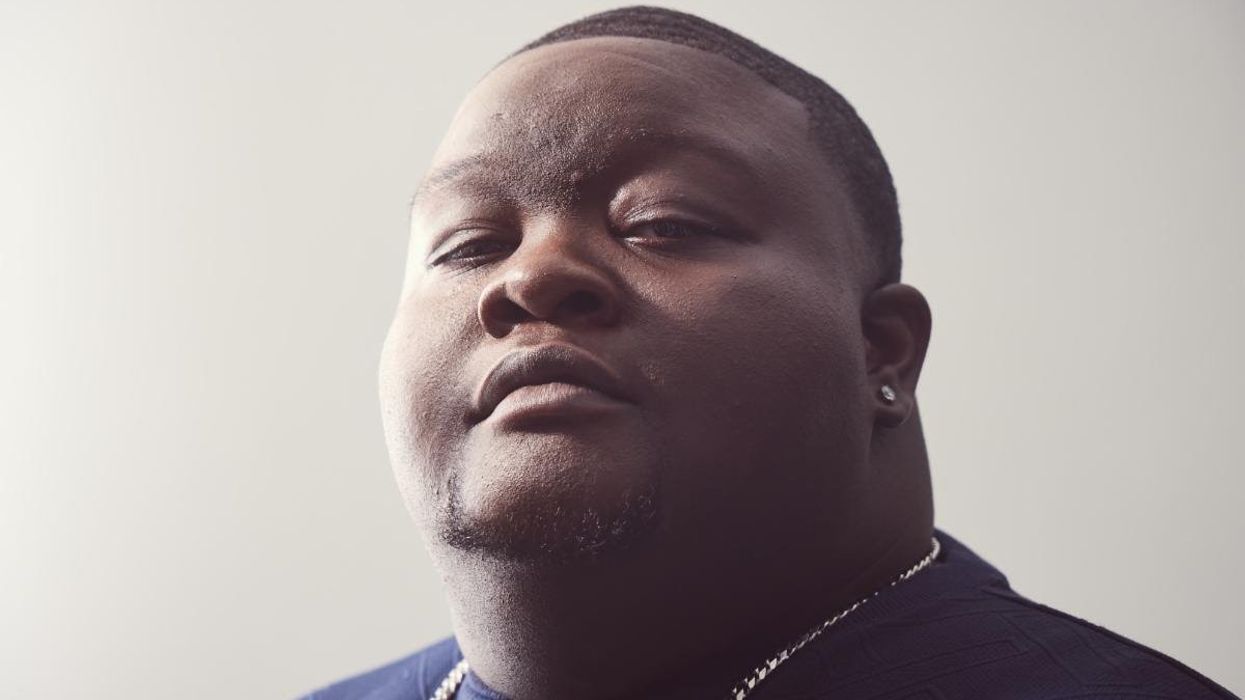
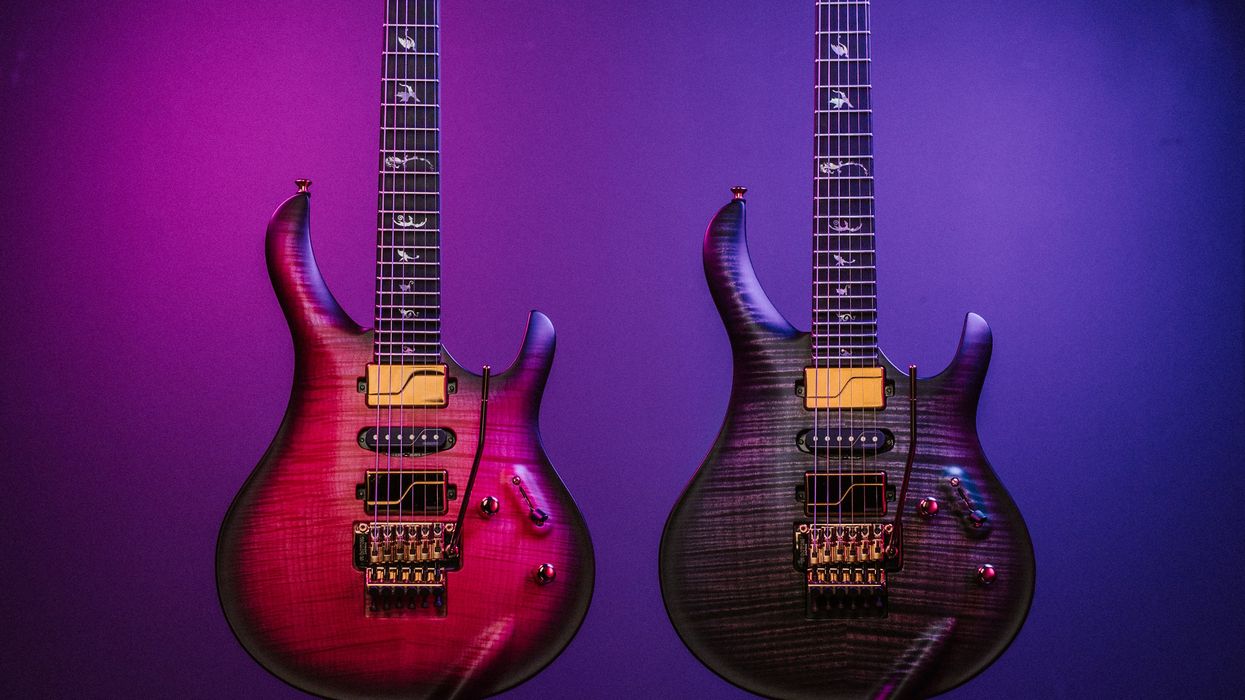
 PRS Guitars Releases “Chleo” Limited Edition Herman Li’s Signature Model
PRS Guitars Releases “Chleo” Limited Edition Herman Li’s Signature Model
